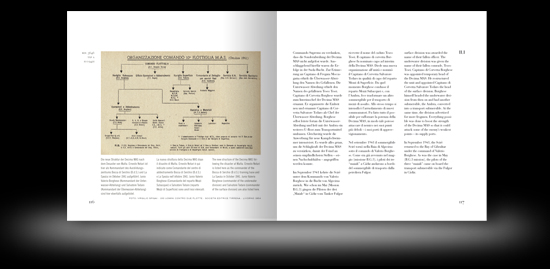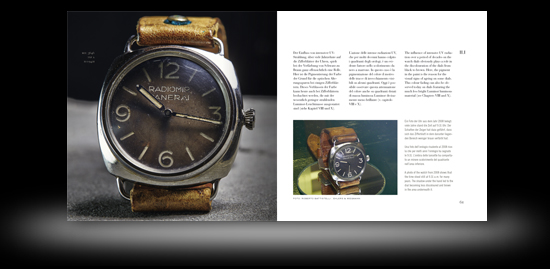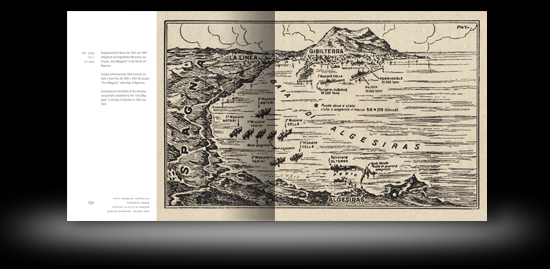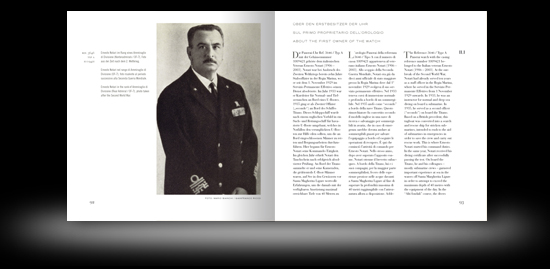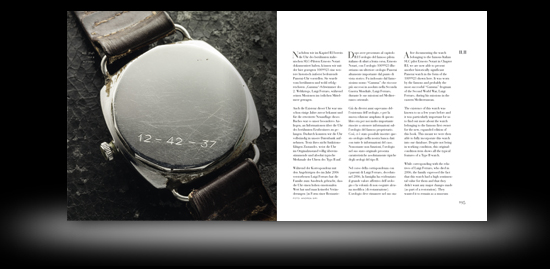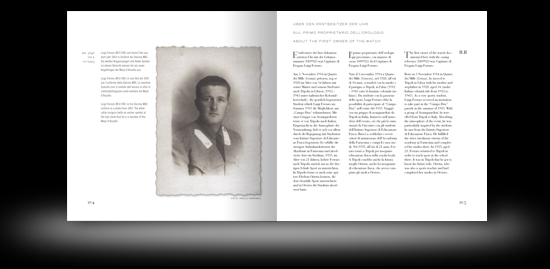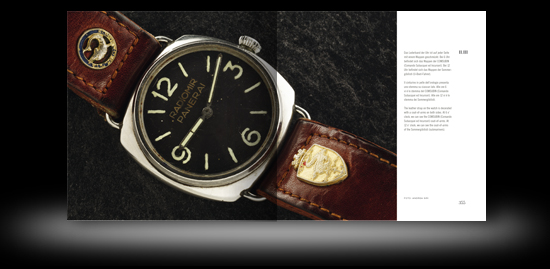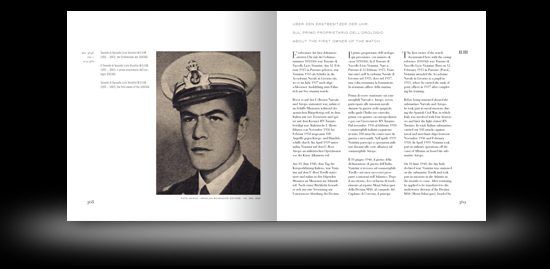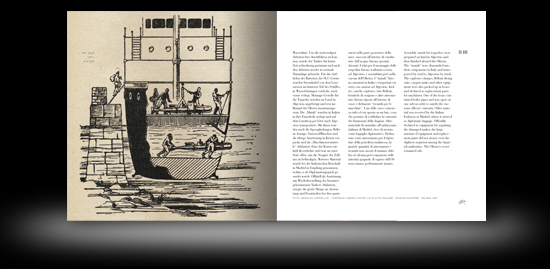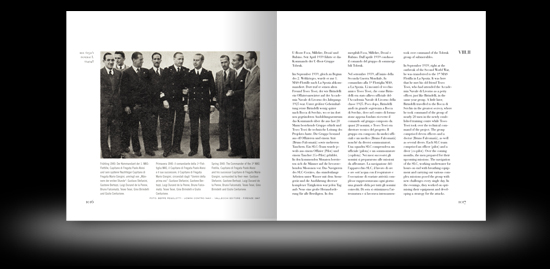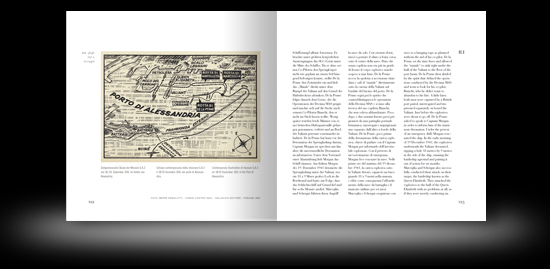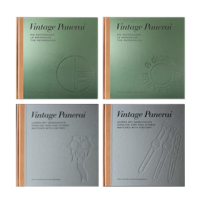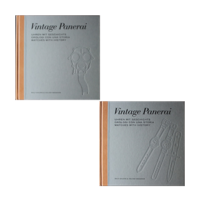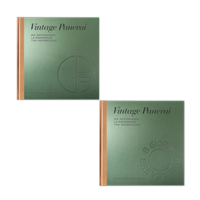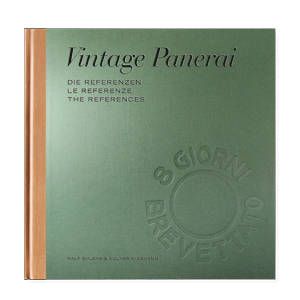Mezzi d’Assalto
by Volker on Apr.14, 2024, under Allgemein
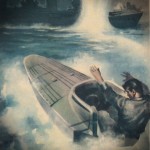 Just a few days before the first success of the MT explosive boats on 26 March 1941 in Souda Bay, the 1st MAS Flotilla changed its name and became the 10th MAS Flotilla – the Decima MAS on 15 March 1941. Capitano di Fregata Vittorio Moccagatta was the new commander and divided the special weaponry – Mezzi d’Assalto – into two divisions:
Just a few days before the first success of the MT explosive boats on 26 March 1941 in Souda Bay, the 1st MAS Flotilla changed its name and became the 10th MAS Flotilla – the Decima MAS on 15 March 1941. Capitano di Fregata Vittorio Moccagatta was the new commander and divided the special weaponry – Mezzi d’Assalto – into two divisions:
The surface division – Mezzi di Superficie – under the command of Capitano di Corvetta Giorgio Giobbe (see photo on page 115, commander Giobbe wearing clearly visible a Panerai watch on his right wrist) had a fleet of various explosive boats (category MT, MTM, MTR, MTS, MTMS, SMA and MTL) for sabotage operations, based in La Spezia.
 The underwater division – Mezzi Subacquei – under the command of Capitano di Corvetta Junio Valerio Borghese operated the diving School in Livorno, the SLC training base at Bocca di Serchio, the transport submersibles (Scirè and Ambra) and the frogmen of the “Gruppo Gamma”.
The underwater division – Mezzi Subacquei – under the command of Capitano di Corvetta Junio Valerio Borghese operated the diving School in Livorno, the SLC training base at Bocca di Serchio, the transport submersibles (Scirè and Ambra) and the frogmen of the “Gruppo Gamma”.
After the desaster at Malta in July 1941 (“Operazione Malta 1”), the Decima MAS was restructured. Capitano di Fregata Ernesto Forza became the new commander of the Decima MAS. The underwater division was given the name of the fallen inventor of the SLC, Teseo Tesei, now commanded by Junio Valerio Borghese. The surface division was given the name of the fallen commander of the Decima, Vittorio Moccagatta, now commanded by Salvatore Todaro. See page 116 with a historical chart of the new structured Mezzi d’Assalto as of October 1941:
Ernesto Notari became commander of the SLC training base at Bocca di Serchio. His Ref. 3646 / Type A “Radiomir Panerai” (with its unique engraved caseback) is documented on page 58 – 91.
Read more about the Mezzi d’Assalto on page 92 – 153 in chapter II.I of the book “The References” 1930’s-1940’s.
26 March 1941 – today in history…
by Volker on Mar.26, 2024, under Allgemein
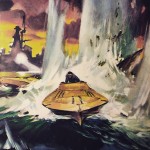 During the winter of 1940-1941 the human torpedo attacks were suspended, at least until the following spring. A detachment of MT explosive boats was based in the Dodecanese, where it trained under the command of Vittorio Moccagatta on the island of Leros with the objective of attacking Souda Bay and the British traffic to Greece.
During the winter of 1940-1941 the human torpedo attacks were suspended, at least until the following spring. A detachment of MT explosive boats was based in the Dodecanese, where it trained under the command of Vittorio Moccagatta on the island of Leros with the objective of attacking Souda Bay and the British traffic to Greece.
Vittorio Moccagatta was ordered back to Italy on 23 January 1941, where he became the commander of the 1st MAS Flotilla in La Spezia. His suggestions to the Italian naval commando assumed in the result that the 1st MAS Flotilla became the 10th MAS Flotilla – the Decima MAS – on 15 March 1941, which was divided into two divisions from that time:
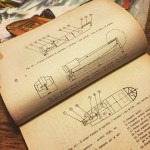 The surface division – Mezzi di Superficie – under the command of Capitano di Corvetta Giorgio Giobbe with a fleet of various explosive boats (category MT, MTM shown by the historic sketches on the left, MTR, MTS, MTMS, SMA, MTL) and motorboats for sabotage operations.
The surface division – Mezzi di Superficie – under the command of Capitano di Corvetta Giorgio Giobbe with a fleet of various explosive boats (category MT, MTM shown by the historic sketches on the left, MTR, MTS, MTMS, SMA, MTL) and motorboats for sabotage operations.
The underwater division – Mezzi Subacquei – under the command of Capitano di Corvetta Junio Valerio Borghese operated the diving School in Livorno, the SLC training base at Bocca di Serchio, the remaining transport submersibles Scirè and Ambra and the frogmen of the “Gruppo Gamma”. On a side note, in early 1941, the two initial transport submersibles for SLC devices, Iride and Gondar, were already lost with the failure of „Operazione G.A.1“ and „Operazione G.A.2“ in August and September 1940.
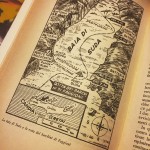 On 26 March 1941, the surface division – Mezzi di Superficie – of the Decima MAS achieved initial successes: six MT-type explosive boats broke through the blockades in Souda Bay (Crete, see historic map on the left) damaging the heavy cruiser York and the tanker Pericles.
On 26 March 1941, the surface division – Mezzi di Superficie – of the Decima MAS achieved initial successes: six MT-type explosive boats broke through the blockades in Souda Bay (Crete, see historic map on the left) damaging the heavy cruiser York and the tanker Pericles.
During the night, the servicemen Luigi Faggioni (commander), Angelo Cabrini, Tullio Tedeschi, Alessio De Vito, Lino Beccati and Emilio Barberi) were transported to the target area aboard the destroyers Crispi and Sella. These two destroyers were equipped with electrically powered cranes for placement of the MT-type explosive boats on the water, which was carried out in just a few minutes, ten miles from Souda’s entrance, at 2330 hours on 25 March 1941. Unnoticed by the enemy, the MT-type explosive boats managed to cross three barricades and reached their targets in the early hours of the morning of 26 March 1941.
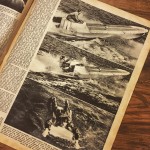 Two MT-type explosive boats attacked the York (the pilots abandoned their boats 80 meters before hitting the ship, see historic photos on the left). Another two MT-type explosive boats attacked the Pericles. Commander Faggioni tried to hit the Coventry but his boat missed the cruiser and exploded on the coast. The sixth MT-type explosive boat missed its target too, but remained intact and was captured by the British. All six pilots of the explosive boats survived the attack and became POW.
Two MT-type explosive boats attacked the York (the pilots abandoned their boats 80 meters before hitting the ship, see historic photos on the left). Another two MT-type explosive boats attacked the Pericles. Commander Faggioni tried to hit the Coventry but his boat missed the cruiser and exploded on the coast. The sixth MT-type explosive boat missed its target too, but remained intact and was captured by the British. All six pilots of the explosive boats survived the attack and became POW.
Read more about the timeline of the missions during the Second World War in chapter II.I on page 106-146. Vittorio Moccagatta is featured on page 112-113, the attack in Souda Bay is featured on page 108-109.
“Operazione Stella” – Luigi Ferraro’s Panerai watch
by Volker on Mar.08, 2024, under Allgemein
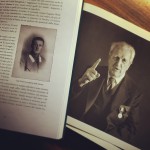 A “Gamma” frogman who wrote history. A photo from 1998 which was a reminder not to miss the chance to capture Luigi Ferraro’s story in our book “The References” – together with the 3646 / Type B watch he was wearing during the “Operazione Stella” in 1943.
A “Gamma” frogman who wrote history. A photo from 1998 which was a reminder not to miss the chance to capture Luigi Ferraro’s story in our book “The References” – together with the 3646 / Type B watch he was wearing during the “Operazione Stella” in 1943.
One of the few watches which can be followed back to the first owner, which is also a very famous one: Luigi Ferraro (M.O.V.M.). Not easy to capture as much as possible of his story in a part in the first volume of “The References”, which filled several books of Italian authors with hundreds of pages. Even in the first Panerai books, written by Giampiero Negretti in 1998, Luigi Ferraro’s famous missions in the mediterranean sea found their place to be mentioned.
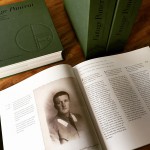 To get in touch with the family of the veteran Luigi Ferraro (1914-2006) was a very intensive and exciting time during the research about his Ref. 3646 / Type B “Radiomir Panerai” with riveted plastic dial (chapter II.II page 190-203). Paolo Ferraro, one of Luigi Ferraro sons, provided excellent photos and made personal documents available for us to be featured in our book, which gave us the chance to illustrate the history behind his father’s watch.
To get in touch with the family of the veteran Luigi Ferraro (1914-2006) was a very intensive and exciting time during the research about his Ref. 3646 / Type B “Radiomir Panerai” with riveted plastic dial (chapter II.II page 190-203). Paolo Ferraro, one of Luigi Ferraro sons, provided excellent photos and made personal documents available for us to be featured in our book, which gave us the chance to illustrate the history behind his father’s watch.
In January 1943 Luigi Ferraro obtained his qualification to carry out underwater missions. Initially posted to North Africa to attack enemy targets in the Port of Tripoli, he had to leave the area and returned to Italy. In May 1943 he was posted to La Spezia, where he received instructions from commander Borghese for a new mission – this time not in North Africa, but in the eastern Mediterranean: the Turkish ports of Alexandretta and Mersina. Luigi Ferraro’s four “Stella” missions, for which he was awarded with the M.O.V.M., are described in chapter II.II (page 204-225).
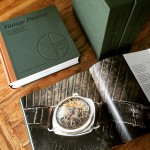 Aside several tools of his time as a “Gamma” frogman, Luigi Ferraro’s 3646 / Type B “Radiomir Panerai” never changed ownership and remained a memorable piece for him and his family since he returned from war. The watch shows intensive proof of aging and is an example of how different these rare watches have aged after more than 70 years. The watch still has its original strap, as well as its original domed plexiglas crystal – intensively aged with countless fissures. Numbers, indices and the typical “Radiomir Panerai” lettering on the riveted plastic dial can still be made out at some points.
Aside several tools of his time as a “Gamma” frogman, Luigi Ferraro’s 3646 / Type B “Radiomir Panerai” never changed ownership and remained a memorable piece for him and his family since he returned from war. The watch shows intensive proof of aging and is an example of how different these rare watches have aged after more than 70 years. The watch still has its original strap, as well as its original domed plexiglas crystal – intensively aged with countless fissures. Numbers, indices and the typical “Radiomir Panerai” lettering on the riveted plastic dial can still be made out at some points.
Luigi Ferraro’s watch has been recorded in our database in 2014, however the watch was known to us already years before. The Rolex 618 / Type 1 movement in combination with the small Oyster Watch Co hallmark, embossed on the inner caseback together with the reference and case number, is matching our criteria for being a watch of the Reference 3646 / Type B. The outer caseback bears a rare matriculation number, of which only a very few 3646 watches are known today. We have published further information about the different matriculation numbers on some of these watches in chapter II.III (page 301-303).
Luigi Ferraro’s 3646 / Type B “Radiomir Panerai” with riveted plastic dial is published extensively in chapter II.II (page 190-203) of the book “The References” 1930’s-1940’s.
More 3646 watches with an interesting history, related to their first owners and the missions they carried out during the Second World War, are introduced in chapter II.I (Ernesto Notari) and in chapter II.III (Licio Visintini). Enjoy reading!
How to visualize a frogman’s pencil written diary from 1945?
by Volker on Feb.16, 2024, under General
During the research on the history behind a Ref. 3646 / Type D “Kampfschwimmer” with engraved caseback, we were able to study the diary of the first owner of the watch. This diary survived the last days of the Second World War and the veteran kept it for decades, willed to share it with us and partially featured in chapter II of our book “History2”.
Thanks to the many detailed descriptions (e.g. the water temperature, current, weather conditions and explosive charges carried) which the frogman wrote down and the examination of historical maps of the 1940’s it was possible to analyze his diary entries precisely and visualize his memories to the readers of our book in an impressive way. The collected documents and additional information let this chapter become one of the unique stories behind a Ref. 3646 / Type D “Kampfschwimmer” watch.
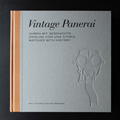 Reading page 83 of “History1” reminds on a part of our research which did happened not often. The frogman wrote the following lines in his diary at the beginning of March 1945:
Reading page 83 of “History1” reminds on a part of our research which did happened not often. The frogman wrote the following lines in his diary at the beginning of March 1945:
“The next morning we set off towards the east in a truck. With unbelievable power, the Russians have pushed thru as far as the [river] Oder in their last offensive. They even managed to build two bridgeheads at Fürstenberg [in November 1961 the city was renamed Eisenhüttenstadt]. Reconnaissance flights tell us that they are putting tremendous amounts of people and material into these bridgeheads”.
Reconnaissance flights? Having this information in mind, we started to search various archives for still existing aerial photographs – maybe the one which the frogmen mentioned in his diary still exists? After the war, some remaining photos were transferred to archives which stored these photos for bomb clearance works. Good luck on the hunt! Guess how easy this search would be? Where to start? To find a aerial photo from the same date, same area and even showing the target, not knowing if its existing at all? We found it – a needle in a haystack – the photo which was shown to the frogmen as their next target.
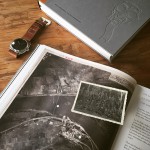 Dated to 1 March 1945, the photo taken by a reconnaissance flight shows one of the pontoon bridges built across the Oder by the Russian troops just shortly before – which became soon later the target for the “Keller Group” just as the frogman wrote it down in his diary. Read more on the diary and various historic documents which helped us to visualize this source of information during our research on a Ref. 3646 / Type D “Kampfschwimmer” watch here.
Dated to 1 March 1945, the photo taken by a reconnaissance flight shows one of the pontoon bridges built across the Oder by the Russian troops just shortly before – which became soon later the target for the “Keller Group” just as the frogman wrote it down in his diary. Read more on the diary and various historic documents which helped us to visualize this source of information during our research on a Ref. 3646 / Type D “Kampfschwimmer” watch here.
The coffee table shot shows page 110-111, chapter II of “History2” next to one of the few original photos of the “Keller Group” taken shortly before their missions at the eastern front (spot some Panerai gear in it). This photo is published on page 94 in the same chapter. The coffee table shot includes also a Ref. 3646 / Type D “Kampfschwimmer”, featured in chapter V of “History2” – the watch of frogman Siegfried Köneke, who was also a member of the “Keller Group”. Read more about this chapter here.
Our two “History” books can be ordered only in our bookstore.
Enjoy reading stories behind these watches!
[Ralf Ehlers & Volker Wiegmann]
The Radiomir which returned from Gibraltar to Italy…
by Volker on Feb.01, 2024, under Allgemein
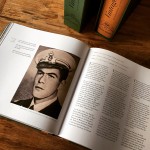 …but alone – without the SLC pilot who used it on his wrist during the mission B.G.5 in December 1942: Licio Visintini.
…but alone – without the SLC pilot who used it on his wrist during the mission B.G.5 in December 1942: Licio Visintini.
Born 1915 and enterred the Royal Italian Navy in 1933, Licio Visintini took part in several missions against the allied fleet in Gibraltar as a member of the Decima MAS. In 1941 Visintini was promoted to Tenente di Vascello. After surviving from SLC missions B.G.3 (May 1941) and B.G.4 (September 1941), carried out by the transport submersible “Scirè” under the command of Junio Valerio Borghese, Visintini returned to Gibraltar undercover in June 1942 where he built the core of the “Orsa Maggiore” on board the tanker Olterra – the hidden base for the SLC units in the bay of Gibraltar.
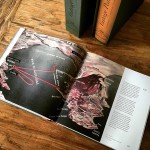 According to legend, Visintini’s „Radiomir Panerai“ was returned to his mother after the end of the Second World War by his former enemy, Lieutenant „Buster“ Crabb (head of the Underwater Working Party in Gibraltar). The return of personal items to relatives showed a great respect that the combatants on different sides had for one another. Crabb, who was himself an experienced diver serving the British Navy, knew from experience all too wellt he level of courage and determination that was neccessary to carry out missions of this kind. Before Visintini’s mother died, she gave the watch to Vittorio Stradi, her son’s best friend. Vittorio Stradi was a „Gamma“ frogman in the Second World War. Fourty years later he passed the watch to his friend Isidoro Mario Nardin, who was also a member of the „Gamma“ frogmen during the Second World War.
According to legend, Visintini’s „Radiomir Panerai“ was returned to his mother after the end of the Second World War by his former enemy, Lieutenant „Buster“ Crabb (head of the Underwater Working Party in Gibraltar). The return of personal items to relatives showed a great respect that the combatants on different sides had for one another. Crabb, who was himself an experienced diver serving the British Navy, knew from experience all too wellt he level of courage and determination that was neccessary to carry out missions of this kind. Before Visintini’s mother died, she gave the watch to Vittorio Stradi, her son’s best friend. Vittorio Stradi was a „Gamma“ frogman in the Second World War. Fourty years later he passed the watch to his friend Isidoro Mario Nardin, who was also a member of the „Gamma“ frogmen during the Second World War.
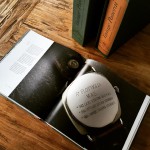 To commemorate the order of ownership, the three names were inscribed for posterity on the caseback, as shown on page 358-359 and 360. For Isidoro Mario Nardin, Licio Visintini’s Panerai watch became a symbol of cameraderie and a memento of his fallen comrade.
To commemorate the order of ownership, the three names were inscribed for posterity on the caseback, as shown on page 358-359 and 360. For Isidoro Mario Nardin, Licio Visintini’s Panerai watch became a symbol of cameraderie and a memento of his fallen comrade.
Chapter II.III in our book “The References” (first volume / 1930’s-1940’s) features the story behind this Ref. 3646 / Type C „Radiomir Panerai“ and its three owners, Licio Visintini (M.O.V.M.), Vittorio Stradi and Isidoro Mario Nardin, on page 350-397.
Information on “The References” 1930’s-1940’s (first volume) can be found here.
Enjoy reading!
[Ralf Ehlers & Volker Wiegmann]
Our database – an interim status on 1 January 2024
by Volker on Jan.16, 2024, under Allgemein
What happened after 1 January 2016 when we “paused” counting new entries in our database for a moment to complete our book set “The References”? We continued to count and still do that – since 2003 (…21 years ago). January 2024 was a good time to pause again and see how our records have changed in numbers of known watches in our database. The total number of all historic Panerai watches in our database from the 1930’s to the 1960’s has grown to 452 known watches.
Back in 2016 we had 211 entries of the Reference 3646 in our database (seven different number groups, from 3646 / Type A to 3646 / Type G). Since then, 55 watches of the References 3646 have been added into our records, making a total of 266 watches of the reference 3646 today. Find an interim status on 1 January 2024 below:
Reference 2533: 3 examples known (2016: 3)
Reference 3646 / Type A: 18 classified (2016: 18)
Reference 3646 / Type B: 21 classified (2016: 16)
Reference 3646 / Type C: 66 classified (2016: 52)
Reference 3646 / Type D: 108 classified (2016: 79)
Reference 3646 / Type E: 32 classified (2016: 26)
Reference 3646 / Type F: 11 classified (2016: 11)
Reference 3646 / Type G: 10 classified (2016: 9)
Mare Nostrum Chronograph: 1 example known (2016: 1)
The watches made by Guido Panerai & Figlio after the Second World War, those with solid lugs, references 6152, 6154, 6152/1 and GPF 2/56 as well as the transitional references and those with Angelus movements increased from 162 to 182. Most additions are watches of the reference 6152/1 – all four versions (Rolex and Angelus movements, Rolex crown and Panerai crown guard) increased from 103 (2016) to 118 specimen classified in our database on 1 January 2024.
Reference 6152 / Type A: 7 classified (2016: 7)
Reference 6152 / Type B: 2 classified (2016: 2)
Reference 6154: 18 classified (2016: 15)
Reference 6152/1 Rolex with Rolex crown: 24 classified (2016: 23)
Reference 6152/1 Rolex with Panerai crown guard: 74 classified (2016: 64)
GPF 2/56 Angelus: 27 classified (2016: 25)
Reference 3646 Angelus: 5 classified (2016: 5)
Reference 3646 Transitional: 5 classified (2016: 5)
Reference 6152/1 Angelus with Rolex crown: 8 classified (2016: 6)
Reference 6152/1 Angelus with Panerai crown guard: 12 classified (2016: 10)
At this point, again, we want to thank those who shared information on the watches lined up above with us. Auctioneers, collectors, veterans or their family members and friends.
Ralf Ehlers & Volker Wiegmann
Naval heritage – Ernesto Notari’s Radiomir
by Volker on Dec.28, 2023, under Allgemein
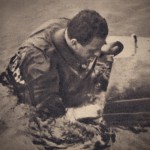 Since 1992, the Vintage Panerai watch which was worn by SLC pilot Ernesto Notari during the Second World War, is on display at the Museo Tecnico Navale in La Spezia. Back then, the watch’s first owner decided to give the watch to the museum on his own wish. It was accepted into the museum’s inventory and since then, it has been on display in a cabinet with other rare items from the Mezzi d’Assalto, where it is resting on one of the last remaining SLC devices.
Since 1992, the Vintage Panerai watch which was worn by SLC pilot Ernesto Notari during the Second World War, is on display at the Museo Tecnico Navale in La Spezia. Back then, the watch’s first owner decided to give the watch to the museum on his own wish. It was accepted into the museum’s inventory and since then, it has been on display in a cabinet with other rare items from the Mezzi d’Assalto, where it is resting on one of the last remaining SLC devices.
In its unaltered original condition, it was an important source of information for us. With the support of the museum we were able to enter all details of the watch into our database. Beside the importance by the history behind, this watch marks the earliest known 3646 / Type A and so became the first watch in chapter II. With its engraved caseback it is of enormous significance with regard to the history of the Mezzi d’Assalto of the Royal Italian Navy.
Page 60 – 61: Comparing photos of Ernesto Notari’s Ref. 3646 / Type A from 2014 and 2008.
Being a member of the Mezzi Subacquei, Ernesto Notari trained at Bocca di Serchio, the secret base of the underwater special unit in Tuscany. In early 1940, the first training exercises were carried out, resulting in the 1935 concept of Teseo Tesei and Elios Toschi evolving into a real, secret weapon. After the desaster of Malta in July 1941, Ernesto Notari was commander of the training base Bocca di Serchio.
In 1943 Notari posted to the secret base in the Bay of Algeciras, the Olterra. After the successful return from mission B.G.6 in May 1943, Notari was awarded with the M.A.V.M. (silver medal for galantry at war) in the rank of Capitano di Corvetta. He solved another successful mission in August 1943: B.G.7, for which he was awarded M.A.V.M. one more time. B.G.7 was the last mission carried out from the tanker Olterra. The declaration of the ceasefire by Italy on 8 September 1943 brought all further plans to an end. The secret of the Olterra was only discovered by the British in October 1943. The undercover missions of the Decima MAS in Gibraltar were therefore highly successful. Although they did not have any major successes like in Alexandria, the continued presence of the Decima for a period of almost three years exercised constant pressure on the British. The use of Villa Carmela and the Olterra as secret starting bases for night-time missions showed the decisiveness of the Decima MAS and its courageous men – one of whom was Ernesto Notari.
Page 150 – 151: Illustration of the missions completed by the “Orsa Maggiore” in the Bay of Algeciras in 1942 and 1943.
After the Second World War, Ernesto Notari continued his career with the Marina Militare. As a Capitano di Fregata, he commanded the reformed special unit from 10 October 1947 to 25 September 1948. As a Capitano di Vascello, Notari served his second captaincy from 1 October 1950 to 14 March 1951. In 1952, he assumed command of the Sezione Tecnica Autonoma in Bacoli. The secret base in the province of Naples existed from 1949 to 1957 before being moved to Varignano as part of a restructuring process . This site was home to some of the remaining Mezzi d’Assalto equipment. By the end of his Navy career, Ernesto Notari had reached the rank of Vice-Admiral (Ammiraglio di Squadra).
Page 92 – 93: About the first owner of the watch, Admiral Ernesto Notari, photo taken after the Second World War.
The watch of Ernesto Notari (a Ref. 3646 / Type A with „Radiomir Panerai“ dial) and the history behind can be read in the book “The References” 1930’s-1940’s (chapter II.I, page 58 to 153). Read more on the Olterra here. Enjoy reading!
Naval heritage – Luigi Ferraro’s Radiomir
by Volker on Dec.27, 2023, under Allgemein
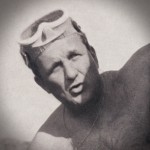 Without a doubt, Luigi Ferraro was a man whose entire life was shaped by the sea. As a talented swimmer, he had been fascinated by the element of water since his youth. During the Second World War, he became one of the best-known frogmen of all time and showed great courage and skill during his dangerous missions, taking himself into the very limits both physically and mentally.
Without a doubt, Luigi Ferraro was a man whose entire life was shaped by the sea. As a talented swimmer, he had been fascinated by the element of water since his youth. During the Second World War, he became one of the best-known frogmen of all time and showed great courage and skill during his dangerous missions, taking himself into the very limits both physically and mentally.
His Radiomir watch, a Ref. 3646 / Type B with riveted plastic dial, has been with him since he was a “Gamma” frogman in the Second World War. With the kind support of his family we were able to document his watch in chapter II.II of our book “The References” together with a view onto his life – before, during and after the war.
Page 194 – 195: View on the engraved caseback of Luigi Ferraro’s 3646 / Type B.
In January 1943, Luigi Ferraro obtained his qualification to carry out underwater missions. He was first posted to North Africa, where he was to attack ships from the British armed forces in the Port of Tripoli. Before the attack could take place, he was ordered back to Italy. Soon later he became an instructor for “Gamma” frogmen of the Mezzi d’Assalto. In May 1943, he was posted to La Spezia and received instructions from Junio Valerio Borghese for a new mission – this time, in the eastern Mediterranean.
Page 204 – 205: About the first owner of the watch. Luigi Ferraro in uniform, photo dated to 1943. The white collar insignia (with an anchor symbol at the top) show that he is a member of the Mezzi d’Assalto.
Luigi Ferraro carried out four missions during July and August 1943 in the Turkish ports of Alexandretta and Mersina. These four missions resulted in the sinking of two ships and the deactivation of a third. Undiscovered and highly successful, the “Operazione Stella” was one of the most effective operations of the Mezzi d’Assalto. Luigi Ferraro was awarded with the M.O.V.M. (gold medal for galantry at war) in the rank of Tenente Artiglieria.
Page 210 – 211: Sketch of two of the four “Stella” missions carried out by Luigi Ferraro in Alexandretta.
After his time as a “Gamma” frogman, he used the skills and abilities he had learnt in the war for civilian purposes. He was able to pass on his extensive knowledge and significant experience to countless divers. Luigi Ferraro was promoted by the Marina Militare to Capitano di Fregata di Complemento in the year 2000.
The watch of Luigi Ferraro (1914 – 2006) and the history behind can be read in the book “The References” 1930’s-1940’s (chapter II.II, page 190 to 225). Read more on “Operazione Stella” here. Enjoy reading!
Naval heritage – Licio Visintini’s Radiomir
by Volker on Dec.26, 2023, under Allgemein
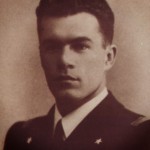 SLC pilot Tenente di Vascello Licio Visintini M.O.V.M. took part on several missions against the allied fleet in Gibraltar as a member of the Mezzi d’Assalto.
SLC pilot Tenente di Vascello Licio Visintini M.O.V.M. took part on several missions against the allied fleet in Gibraltar as a member of the Mezzi d’Assalto.
After returning from the SLC missions B.G.3, being pilot of SLC 160 in May 1941 and B.G.4, being pilot of SLC 220 in September 1941 (both carried out from the transport submersible “Scirè” under the command of Junio Valerio Borghese), Licio Visintini, twice awarded with the silver medal for galantry at war (M.A.V.M.), returned to Gibraltar undercover in June 1942. He built the core of the “Orsa Maggiore” on board the tanker Olterra – the new, hidden base for the SLC units in the bay of Gibraltar (which remained undiscovered until September 1943). Read more on the Olterra here.
After months of preparations and training in complete secrecy, the SLC mission B.G.5 took progress in December 1942 with three SLC devices of the 200-series: 228, 229 and 236. For Licio Visintini, Giovanni Magro and Salvatore Leone it was a missions with no return. Read the complete story about their fateful SLC mission and how Licio Visintini’s Ref. 3646 / Type C with “Radiomir Panerai” dial returned to Italy and changed ownership two times after, on page 368-397.
Page 354 – 355: Licio Visintini’s 3646 / Type C. The strap has been decorated with coat-of-arms of the Sommergibilisti (submariners) and COMSUBIN (Raggruppamento subacquei e incursori “Teseo Tesei”). The Rolex movement of the watch has been introduced here.
Page 368 – 369: About the first owner of the watch. Tenente di Vascello Licio Visintini M.O.V.M.
Page 386 – 387: Illustration of the secret SLC base Olterra at the pier in Algeciras / Bay of Gibraltar.
The watch of Tenente di Vascello Licio Visintini (1915 – 1942) and the history behind can be read in the book “The References” 1930’s-1940’s (chapter II.III, page 350 to 397). Read more on Licio Visintini here. Enjoy reading!
Naval heritage – Luigi Durand de la Penne
by Volker on Dec.25, 2023, under Allgemein
 Luigi Durand de la Penne was one of the famous SLC pilots of the Mezzi d’Assalto who wrote naval history in the Second World War. Luigi Durand de la Penne was born in Genoa, where he also died (11 February 1914 – 17 January 1992). He graduated from the Naval Academy in Livorno in 1934. He was one of the first crewmen of the 1° Gruppo Sommergibili who realized Teseo Tesei’s and Elios Toschi’s idea of a new, secret weapon in La Spezia: The SLC. At the training base Bocca di Serchio he was a member of the legendary group which founded the famous „Spirito del Serchio“.
Luigi Durand de la Penne was one of the famous SLC pilots of the Mezzi d’Assalto who wrote naval history in the Second World War. Luigi Durand de la Penne was born in Genoa, where he also died (11 February 1914 – 17 January 1992). He graduated from the Naval Academy in Livorno in 1934. He was one of the first crewmen of the 1° Gruppo Sommergibili who realized Teseo Tesei’s and Elios Toschi’s idea of a new, secret weapon in La Spezia: The SLC. At the training base Bocca di Serchio he was a member of the legendary group which founded the famous „Spirito del Serchio“.
The first remarkable milestones of his naval career was the rescue action of the transport submarine for SLC devices, the Iride: On 22 August 1940, in the Gulf of Bomba, the Iride was sunk by a torpedo released by a British Swordfish bomber. The air attack happened during an exercise, in shallow water, when four SLC teams were around, including the officers Teseo Tesei, Gino Birindelli and Luigi Durand de la Penne. They started an immediate rescue action. Of the 12 Iride crewmen who survived, two died during an unsuccessful attempt to surface, nine were retrieved alive (two of them died soon, due to wounds), and one was too shocked to leave the sunken submarine. Luigi Durand de la Penne tried to persuade him to surface, and even gave him his own rebreather, but the seaman refused surfacing and died.
Page 1016 – 1017: “Uomini della prima ora” – spring 1940 – before the mission G.A.1 failed dramatically. Luigi Durand de la Penne (3rd from left) together with the commanders of the 1st MAS Flotilla (Aloisi and Giorgini), surrounded by Stefanini, Bertozzi, Falcomatà, Tesei, Birindelli and Centurione.
The second milestone in Luigi Durand de la Penne’s naval career was the sinking of the British battleship Valiant. In December 1941, he was one of the “fab six” (Emilio Bianchi, his co-pilot; Antonio Marceglia with Spartaco Schergat and Vincenzo Martellotta with Mario Marino) that attacked the Port of Alexandria. As a result, four ships were disabled: the British battleships HMS Queen Elizabeth and HMS Valiant, the oil tanker Sagona and the destroyer HMS Jervis. Luigi Durand de la Penne was awarded the M.O.V.M. (the Italian highest military decoration awarded for valour “in the face of the enemy”). At the end of the war, Admiral Charles Morgan (the Valiant’s Captain at the time of the attack in Alexandria) wanted to confer himself the medal to Luigi Durand de la Penne in a ceremony in Taranto.
Page 122 – 123: Illustration of the mission G.A.3 on 18/19 December 1941 in the Port of Alexandria.
After 8 September 1943, Luigi Durand de la Penne was offered the opportunity to be released from prison and fight for the Allies. He accepted and returned to duty as a frogman. In June 1944, he participated in a joint Italian/British operation against the Germans (mission QWZ). A team of British and Italian divers sank the cruisers Gorizia and Bolzano before they could be used to block the harbour entrance. After the Second World War, Luigi Durand de la Penne stayed in the Marina Militare. He was promoted to Capitano di Fregata in 1950 and Capitano di Vascello in 1954. In 1956 he was appointed as Naval Attaché in Brazil.
Luigi Durand de la Penne‘s family donated decorations he was awarded during his career, and his Panerai watch to the museum at the COMSUBIN headquarters in Varignano / La Spezia. The Panerai watch, a Ref. 3646 / Type C with “Radiomir Panerai” dial has been recorded in our database in 2015. Enjoy reading more: Luigi Durand de la Penne M.O.V.M. is featured in chapter I (page 35), chapter II.I (page 94-123) and VIII.II (page 1016-1034) of our two “The References” books.

